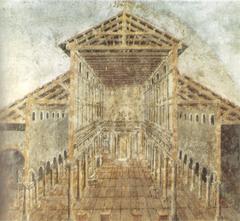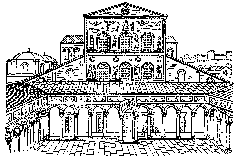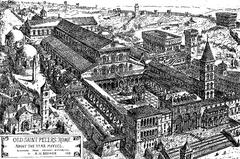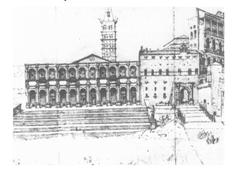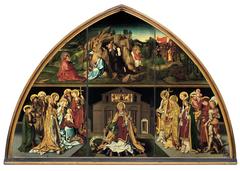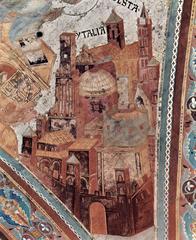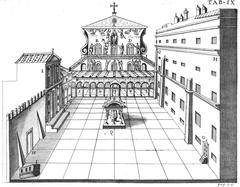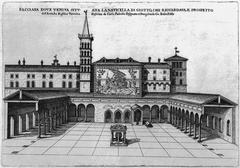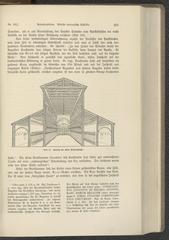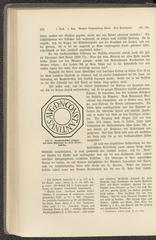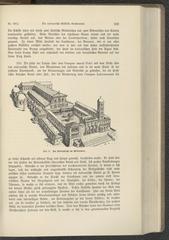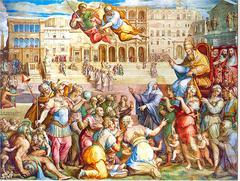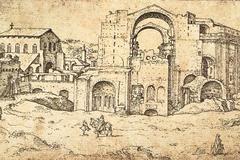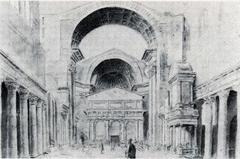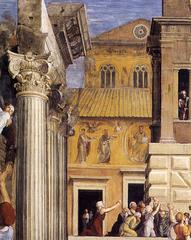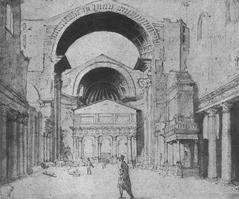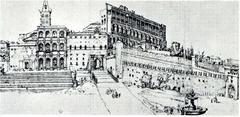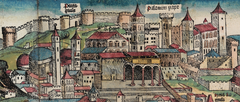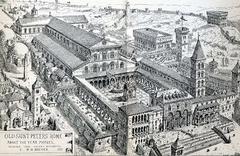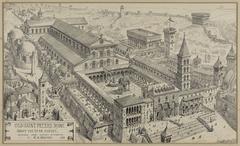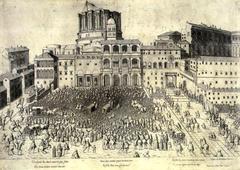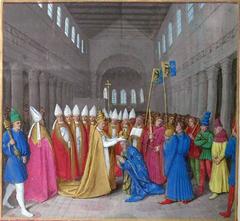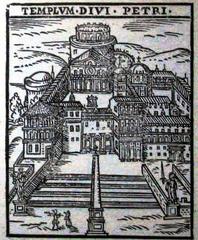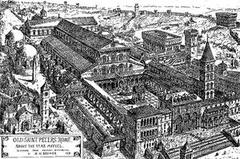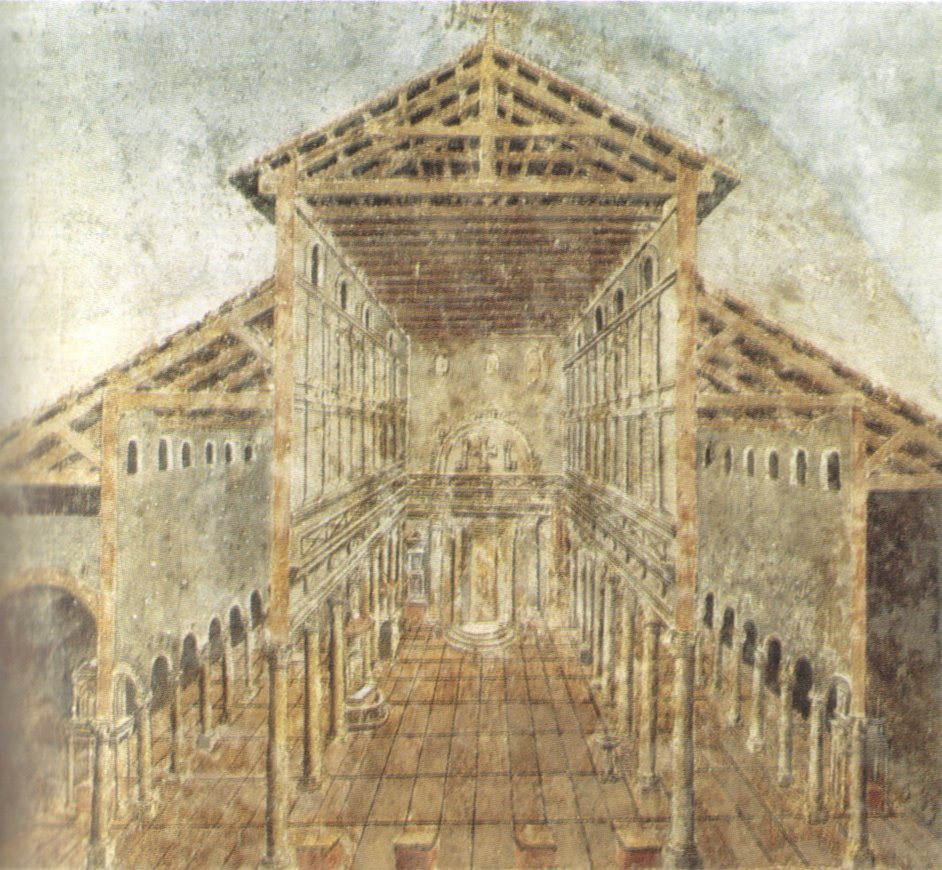
Old St. Peter’s Basilica, Rome: Visiting Hours, Tickets, and Comprehensive Guide
Date: 14/06/2025
Introduction
Old St. Peter’s Basilica, constructed on Vatican Hill in Rome, Italy, is one of the world’s most significant Christian sites. Built in the early 4th century by Emperor Constantine the Great, it was consecrated in 326 CE directly over what was believed to be the tomb of Saint Peter—the first pope and a foundational figure in Christianity. Its architectural grandeur, spiritual significance, and cultural influence made it a pilgrimage destination and a symbol of papal authority for over a millennium (Britannica; World History Edu).
Though the original basilica was replaced by the current Renaissance structure in the 16th century, archaeological excavations beneath the new St. Peter’s have revealed remnants of the Constantinian church and the ancient necropolis, preserving the site’s sacred legacy (ArcheoRoma). Today, visitors can explore this rich history and enjoy practical amenities, including regular visiting hours, guided tours, and accessible facilities, ensuring an enriching experience for all (Headout; Walks of Italy).
Table of Contents
- Historical Overview & Foundations
- Architectural Design and Artistic Masterpieces
- Religious and Cultural Significance
- Modifications, Decline, and Demolition
- Archaeological Discoveries and Legacy
- Visitor Information: Hours, Tickets, and Accessibility
- Travel Tips and Nearby Attractions
- FAQs
- Visuals and Interactive Resources
- Related Articles
- Summary and Call to Action
Historical Overview & Foundations
Early Construction
Old St. Peter’s Basilica was commissioned by Constantine the Great after Christianity was legalized in the Roman Empire. Construction began between 319 and 322 CE and was completed around 349 CE. It was built on the Vatican Hill, above the site believed to be St. Peter’s burial place, making the basilica a central pilgrimage site from its earliest days (Britannica; ArcheoRoma).
Architectural Design and Artistic Masterpieces
Layout and Structure
The basilica introduced the five-aisled basilican plan, blending Roman civic architecture with Christian liturgical needs. Its nave, flanked by double aisles separated by marble columns, led to an apsed transept where the papal altar stood above St. Peter’s tomb. A notable feature was the grand atrium, or “Paradise,” a colonnaded courtyard with gardens and fountains, symbolizing spiritual preparation before entering the church (Wikipedia; italy-tourist-information.com).
Artistic Highlights
- Mosaics and Frescoes: The nave and apse were richly decorated with mosaics depicting biblical scenes, saints, and Christ, serving both as religious instruction and artistic marvels.
- Papal Tombs and Relics: The basilica housed the Confessio, providing access to St. Peter’s tomb. Numerous popes and martyrs were buried here, their tombs adorned with elaborate mosaics and sarcophagi.
- Marble and Spolia: Many columns and decorative features were crafted from repurposed materials from earlier Roman buildings, symbolizing Christianity’s triumph over paganism (Wikipedia; italy-tourist-information.com).
Religious and Cultural Significance
From its foundation, Old St. Peter’s served as a spiritual epicenter for Western Christianity and a key symbol of papal authority. Major liturgical events, papal coronations, and ecumenical councils were held here. Pilgrims flocked to venerate St. Peter’s relics, establishing a tradition that continues in the modern basilica (ArcheoRoma; Headout).
Its architectural innovations—such as the atrium and cruciform layout—set standards for church construction across Europe, while its mosaics and relics inspired generations of artists and pilgrims (World History Edu; Vox Mundi).
Modifications, Decline, and Demolition
Over time, the basilica underwent numerous alterations by successive popes to accommodate evolving liturgical practices and artistic tastes. By the late Middle Ages, structural deterioration and damage necessitated major repairs. In the early 16th century, Pope Julius II ordered its demolition to make way for the present Renaissance basilica, completed in 1626 (ArcheoRoma; Headout).
Archaeological Discoveries and Legacy
Twentieth-century excavations beneath the current basilica revealed the ancient necropolis and fragments of the original Constantinian foundations, affirming the site’s historical and spiritual significance (ArcheoRoma). Today, the Vatican Grottoes and Scavi Tours allow visitors to experience this remarkable heritage firsthand (archtene.com).
Visitor Information: Hours, Tickets, and Accessibility
Visiting Hours
- Basilica: Open daily, typically from 7:00 AM to 7:00 PM (April–September), and until 6:00 PM (October–March). Last entry is one hour before closing (Walks of Italy).
- Vatican Museums & Scavi: Open Monday to Saturday, 9:00 AM–6:00 PM (last entry 4:00 PM). Necropolis (Scavi) tours require advance reservation.
Tickets and Guided Tours
- General Entry: Free for St. Peter’s Basilica, but security checks are mandatory.
- Dome (Cupola) Climb: €8 (stairs only) or €10 (elevator plus stairs).
- Vatican Grottoes: Free; restricted access during events.
- Scavi Tour (Necropolis): Paid guided tours (advance booking essential).
- Guided Tours & Audio Guides: Available from official and authorized third-party providers (Vox City).
Dress Code and Security
- Shoulders and knees must be covered; sleeveless tops, shorts, and hats are not permitted (Walks of Italy).
- All visitors pass through airport-style security.
Accessibility
- Wheelchair access, ramps, and elevators are available for the basilica and most public areas.
- The dome ascent is not fully accessible.
- Contact Vatican visitor services for special accommodations.
Travel Tips and Nearby Attractions
- Getting There: Accessible via Rome Metro Line A (Ottaviano or Cipro stations) and several bus lines. Walking from the city center is rewarding.
- Nearby Sights: Vatican Museums, Sistine Chapel, Vatican Gardens, Castel Sant’Angelo, and St. Peter’s Square.
- Best Times: Early mornings or late afternoons to avoid crowds; avoid Wednesdays if you wish to skip papal audiences.
Frequently Asked Questions (FAQs)
Q: What are Old St. Peter’s Basilica visiting hours?
A: The current basilica is open daily, typically 7:00 AM to 7:00 PM (summer), and until 6:00 PM (winter). Always confirm before visiting.
Q: Do I need tickets for entry?
A: Entry to the basilica is free. Tickets are required for the dome, Scavi, and some guided tours.
Q: Is the basilica accessible?
A: Yes, with ramps and elevators for most areas.
Q: How do I visit St. Peter’s tomb?
A: Through the Scavi Tour, booked well in advance.
Q: Are guided tours available?
A: Yes, in multiple languages, both official and third-party options.
Q: Can I take photos?
A: Yes, without flash or tripods.
Visuals and Interactive Resources
- Virtual Tour of St. Peter’s Basilica (official Vatican resource)
- Use descriptive alt tags for images, such as “Old St. Peter’s Basilica historical ruins” and “St. Peter’s Basilica visiting hours”.
Related Articles
Summary
Old St. Peter’s Basilica remains an enduring testament to Christian faith, architectural innovation, and cultural legacy. Its foundational role over Saint Peter’s tomb established a centuries-long tradition of pilgrimage and spiritual authority. While the original structure no longer stands, its influence is preserved in the current basilica and through ongoing archaeological research. Planning your visit—mindful of hours, ticketing, dress code, and accessibility—ensures a rewarding experience at one of history’s most revered religious sites (World History Edu; Britannica; ArcheoRoma; Headout; Walks of Italy; The Roman Guy; Vox City).
Call to Action
Enhance your visit with expert-guided audio tours and up-to-date information by downloading the Audiala app. Follow us on social media for travel tips, ticket updates, and exclusive content on Rome’s historical treasures. Begin your journey into the heart of Christian heritage today.
References
- Old Saint Peter’s Basilica – Britannica
- History of St. Peter’s Basilica – World History Edu
- Old St. Peter’s Basilica – Wikipedia
- St. Peter’s Basilica – Italy Tourist Information
- Old St. Peter’s Basilica – Totally History
- How has St. Peter’s Basilica influenced religious and cultural history? – Vox Mundi
- Papal Basilica of St. Peter, Vatican – ArcheoRoma
- St. Peter’s Basilica Rome: Visiting Hours, Tickets & Travel Tips – Headout
- Visiting St. Peter’s Basilica: Tips and Hours – Walks of Italy
- Top Things to See at St. Peter’s Basilica – The Roman Guy
- The Top 10 Must-See Highlights of St. Peter’s Basilica – Vox City
- St. Peter’s Basilica Architecture – ArchTene
